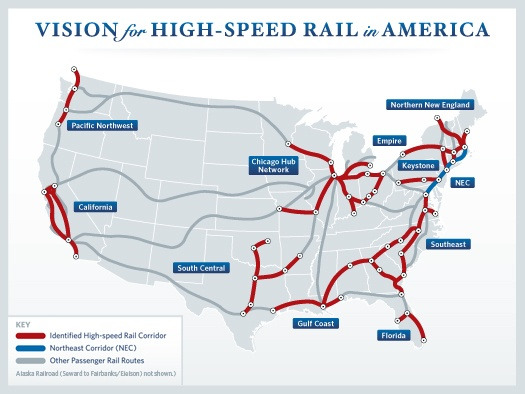Chicago to be a High-Speed Rail Hub?
By Kevin Robinson in News on Apr 17, 2009 12:45PM
Before leaving for Mexico to meet with Mexican President Felipe Calderon, President Barack Obama outlined his vision for a series of high-speed rail corridors around the nation, including a nine-state, 3,000 mile Midwestern network that features Chicago as a hub. "High-speed intercity passenger rail can play a critical role in certain travel markets, but the United States has historically failed to invest in this mode," said a statement released by the White House. "The president proposes a long-term strategy intended to build an efficient, high-speed passenger rail network of 100- to 600-mile intercity corridors as one element of a modernized transportation system."

Image via the White House
"What we're talking about is a vision for high-speed rail in America. Imagine boarding a train, in the center of a city, no racing to an airport and across a terminal, no delays, no sitting on the tarmac, no lost luggage, no taking off your shoes," Obama said during a press conference with Vice President Joe Biden and Transportation Secretary Ray LaHood. He plans to use funds from the American Recovery and Reinvestment Act to finance the projects. " To make this happen, we've already dedicated $8 billion of Recovery and Reinvestment Act funds to this initiative, and I've requested another $5 billion over the next five years. The Department of Transportation expects to begin awarding funds to ready projects before the end of this summer, well ahead of schedule. And like all funding decisions under the Recovery Act, money will be distributed based on merit -- not on politics, not as favors, not for any other consideration; purely on merit."
High-speed trains could be zipping through Chicago as early as 2012 or 2014, and would run to Milwaukee and Madison on one corridor, Detroit and Pontiac on another. Those routes would be followed later by high-speed lines to the Twin Cities, Indianapolis, Cleveland, Cincinnati, Kansas City, and Louisville and other cities. Outside of the Chicago hub, nine other corridors have been identified by the federal government as having the most potential for success. Those corridors include include a northern New England line, a line running east to west in New York State, a corridor running laterally through Pennsylvania, a southeast network connecting the District of Columbia to Florida and the Gulf Coast, a Gulf Coast line extending from eastern Texas to western Alabama, a corridor in central and southern Florida, a Texas-to-Oklahoma line, a California line from San Francisco to Los Angeles and a corridor in the Pacific Northwest.